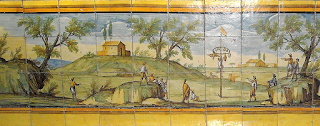 |
| Chloe Salmon reaches the top of the greasy pole and clutches her prize of cash. Photograph by Sarah Scragg, State Library of Queensland: Australian Italian Festival |
 |
| Picture attribution: Landscape with greasy pole. Majolica Cloister of Santa Chiara, Naples, (1739-42). Architect Domenico Antonio Vaccaro, painters, Guiseppe and Donato Massa. |
We repeat community and family traditions, but often we don't know where or how they originated. The greasy pole, which features at each Australian Italian Festival is such a tradition. Everybody enjoys the spectacle and amusement but does anybody know the origins of this challenge? It began in a time when the poor and the rich ate very, very different foods. The competition, which requires strategy and stamina, traditionally, has as its reward, foods of some value, like prosciutto e formaggio! Winners of the greasy climb were rewarded with food that was usually unavailable to them.
Peter Robb in a work called Street Fight in Naples: A City’s Unseen History has this to say
about the history of the greasy pole. “All over Europe the Tree of Cockaigne
was part of the carnival festivities that preceded the austerities of Lent. It
was basically a greasy pole with a couple of sausages tied to the top and
whoever reached them first won the sausages. In Naples the Land of the Cockaigne
was always more elaborate, Naples having more poor people than anywhere else in
Europe. The rewards were greater and so was the violence of the contest. The
Land of the Cockaigne involved painted scenery and an ersatz forest of trees, a complex construction usually
described as the Cockaigne machine, bearing
cheeses, hams, sausages and other delights in their upper branches. The mass
assault on the food was a brawl that always ended in shed blood, broken and
bones and quite often deaths. It was an entertaining and reassuring sight for
those who were not themselves hungry, and choreographed for laughs.”
The Land of Cockaigne comes from Dutch literature and refers
to Luilekkerland which is the land of
the lazy and the gluttonous. In popular stories this land was described as a “mythical
place where there is no need to work, and where food and drink are so abundant
that we only need to open our mouths to take in what we desire.” The Land of Cockaigne is the subject of many
famous artists’ paintings.
Next time you watch and laugh as keen competitors slip and
slide down and hopefully up the pole spare a thought to the hungry of Naples for
whom long ago, the prize meant more than life and for whom the risk of scaling
the pole could be injury or death.
Sources: Robb,
Peter. Street Fight in Naples: A City’s
Unseen History.London: Bloomsbury,
2010.
“Heilbrunn
Time Line of Art History,” The Met, http://www.metmuseum.org/toah/works-of-art/26.72.44/.
No comments:
Post a Comment